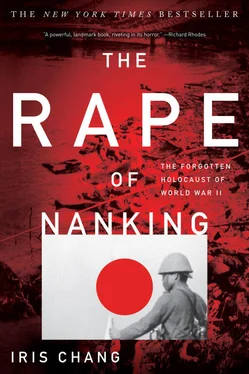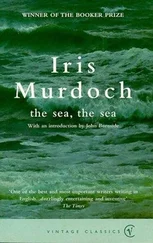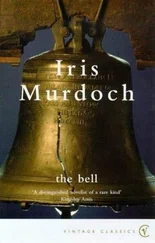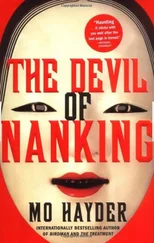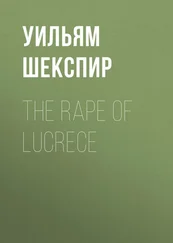145. During the massacre most were so frightened: C. Yates McDaniel, “Nanking Horror Described in Diary of War Reporter,” Chicago Tribune, December 18, 1937.
146. “I didn’t know where to take him or what to do”: “Mr. Tillman Durdin’s Statement on the News Conference—Refuting the Distortions of His Reports on the Great Nanking Massacre by the Japanese Media,” Journal of Studies of Japanese Aggression Against China , August 1992, p. 66.
146. “I could do nothing”: McDaniel, “Nanking Horror Described in Diary of War Reporter.”
146. Details of Durdin’s and Steele’s last day in Nanking can be found in their news reports, Fitch’s diary, and in “Mr. Tillman Durdin’s Statement on the News Conference.”
146. There were also two American newsreel men: For information on Norman Alley and Eric Mayell filming the attack, see “Camera Men Took Many Panay Pictures,” New York Times, December 19, 1937.
146. Though they survived the attack unscathed: Steele, “Chinese War Horror Pictured by Reporter.”
146. While hiding with the surviving Panay passengers: Hamilton Darby Perry, The Panay Incident: Prelude to Pearl Harbor (Toronto: Macmillan, 1969), p. 226.
146. On December 13, President Franklin D. Roosevelt: United Press story printed in Chicago Daily News, December 13, 1937.
146. Filthy, cold, and wearing only blankets: “Sinking of the U.S.S. Panay, ” ch. 11 of Some Phases of the Sino-Japanese Conflict (July–December 1937), compiled from the records of the Commander in Chief, Asiatic Fleet, by Capt. W. A. Angwin (MC), USN, December 1938, Shanghai, Office of the Chief of Naval Operations, Division of Naval Intelligence, general correspondence, 1929–42, folder P9–2/EF16#23, box 284, entry 81, record group 38, National Archives.
147. When Alley’s and Mayell’s footage hit the theaters: United Press story printed in Chicago Daily News, December 29, 1937; 793.94/12177, General Records of the Department of State, record group 59, National Archives.
147. “The embassy cuts no ice”: Copy of George Fitch diary, enclosed in file from Assistant Naval Attaché E. G. Hagen to Chief of Naval Operations, March 7, 1938, National Archives.
147. In February they allowed a few American naval officers: Commanding Officer to the Commander in Chief, U.S. Asiatic Fleet (letterhead marked the U.S.S. Oahu ), intelligence summary for the week ending February 20, 1938, February 21, 1938, Office of the Chief of Naval Operations, Division of Naval Intelligence, general correspondence, 1929–42, folder A8–21/FS#3, box 195, entry 81, record group 38, National Archives.
147. As late as April: “Red Machine” Japanese diplomatic messages, no. 1794, translated May 4, 1938, boxes 1–4, record group 457, National Archives.
147. “The assumption I made”: “Deutsche Botschaft China,”document no. 214, German diplomatic reports, National History Archives, Republic of China. According to this report, the German diplomats returned to the city on January 9, 1938.
148. A machine cipher had protected: For information on the American Red Machine, see David Kahn, “Roosevelt, Magic and Ultra,” in Historians and Archivists, ed. George O. Kent (Fairfax, Va.: George Mason University Press, 1991).
148. “If they do return”: “Red Machine” Japanese diplomatic messages, no. 1171, record group 457, National Archives.
148. For example, Norman Alley: Perry, The Panay Incident, p. 232.
149. “utmost secrecy”: “Red Machine” Japanese diplomatic messages, box 2, record group 457, National Archives.
149. “If that is all the news coming out of Nanking”: Robert Wilson, letter to family, December 20, 1937.
149– “Carefully they were herded”: George Fitch diary, reprinted in
150. Reader’s Digest (July 1938).
150. “tremendously pleased”: George Fitch, My Eighty Years in China, p. 115.
150. “spontaneous” celebrations: Reader’s Digest (July 1938).
150. “these acts were not repeated”: The Smythes, letter of March 8, 1938, box 228, record group 8, Yale Divinity School Library.
150. “the Imperial Army entered the city”: Archives of David Magee. A copy of the article can also be found in George Fitch diary, enclosed in file from Assistant Naval Attaché E. G. Hagen to Chief of Naval Operations, March 7, 1938, National Archives.
151. “Now the Japanese are trying to discredit”: James McCallum, diary entry for January 9, 1938 (copy), box 119, record group 119, Yale Divinity School Library, reprinted in Smalley, American Missionary Eyewitnesses to the Nanking Massacre, p. 43.
151. “We have seen a couple of issues”: copy of George Fitch diary, entry for January 11, 1938, enclosed in file from Assistant Naval Attaché E. G. Hagen to Chief of Naval Operations, March 7, 1938, National Archives.
151. “In March, a government radio station in Tokyo”: Reader’s Digest (July 1938).
151. “Now the latest is from the Japanese paper”: Lewis and Margaret Smythe, letter to “Friends in God’s Country,” March 8, 1938, box 228, record group 8, Yale Divinity School Library.
152. “All good Chinese who return”: Reader’s Digest (July 1938).
152. “a charming, lovable soldier”: “Deutsche Botschaft China,” document starting on page 107, March 4, 1938, National History Archives, Republic of China.
152. In early February a Japanese general: Ernest Forster, letter of February 10, 1938, Ernest and Clarissa Forster Collection.
153. “a mother of an 11-year-old girl”: “Deutsche Botschaft China,” document starting on page 134, February 14, 1938, National History Archives, Republic of China.
153. The Japanese government barred other reporters: “Red Machine” Japanese diplomatic messages, D(7–1269) #1129–A, boxes 1–4, record group 457, National Archives.
153. Superior training in the verbal arts: John Gillespie Magee, Sr., was the father of John Gillespie Magee, Jr., who served in the Royal Canadian Air Force and wrote the famous World War II poem, “High Flight.” (“Oh! I have slipped the surly bonds of earth/And danced the skies on laughter-silvered wings…”).
154. “Complete anarchy has reigned”: copy of George Fitch diary, diary entry for December 24, 1937, enclosed in file from Assistant Naval Attaché E. G. Hagen to Chief of Naval Operations, March 7, 1938, National Archives, reprinted in Fitch, My Eighty Years in China, p. 98.
154. “It is a horrible story to try to relate”: James McCallum, diary entry for December 19, 1937 (copy), box 119, record group 8, Yale Divinity School Library, reprinted in Smalley, American Missionary Eyewitnesses to the Nanking Massacre, p. 21.
155. “I think I have said enough”: John Magee, letter to his wife, December 31, 1937, archives of David Magee.
155. “Please be very careful of this letter”: John Magee, letter to “Billy” (signed “John”), January 11, 1938, Ernest and Clarissa Forster Collection.
155. “sensation”: Fitch, My Eighty Years in China , p. 92.
155. “What I am about to relate”: copy of George Fitch diary, diary entry for December 24, 1937, enclosed in file from Assistant Naval Attaché E. G. Hagen to Chief of Naval Operations, March 7, 1938, National Archives, reprinted in Fitch, My Eighty Years in China, pp. 97–98.
Читать дальше
